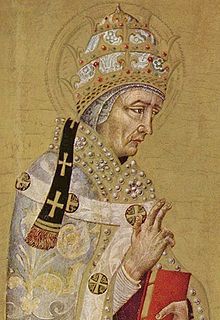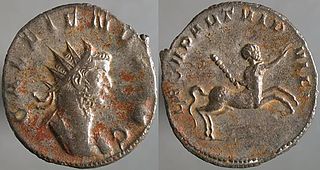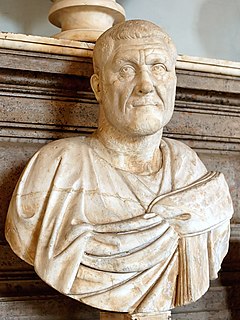Related Research Articles
The 170s decade ran from January 1, 170, to December 31, 179.

Year 236 (CCXXXVI) was a leap year starting on Friday of the Julian calendar. At the time, it was known as the Year of the Consulship of Verus and Africanus. The denomination 236 for this year has been used since the early medieval period, when the Anno Domini calendar era became the prevalent method in Europe for naming years.

Year 253 (CCLIII) was a common year starting on Saturday of the Julian calendar. At the time, it was known as the Year of the Consulship of Volusianus and Claudius. The denomination 253 for this year has been used since the early medieval period, when the Anno Domini calendar era became the prevalent method in Europe for naming years.
The 230s decade ran from January 1, 230, to December 31, 239.

The Crisis of the Third Century, also known as the Military Anarchy or the Imperial Crisis, was a period in which the Roman Empire nearly collapsed. The crisis ended due to the military victories of Aurelian and with the ascension of Diocletian and his implementation of reforms in 284, including the Tetrarchy.

Gordian III was Roman emperor from 238 to 244. At the age of 13, he became the youngest sole emperor up to that point. Gordian was the son of Antonia Gordiana and Junius Balbus, who died before 238. Antonia Gordiana was the daughter of Emperor Gordian I and younger sister of Emperor Gordian II. Very little is known of his early life before his acclamation. Gordian had assumed the name of his maternal grandfather in 238.

Gordian I was Roman emperor for 22 days with his son Gordian II in 238, the Year of the Six Emperors. Caught up in a rebellion against the Emperor Maximinus Thrax, he was defeated by forces loyal to Maximinus, and he committed suicide after the death of his son.

Gordian II was Roman emperor with his father Gordian I in 238 AD, the Year of the Six Emperors. Seeking to overthrow Maximinus Thrax, he died in battle outside Carthage. Since he died before his father, Gordian II had the shortest reign of any Roman emperor, at 22 days.

Legio II Parthica was a legion of the Imperial Roman army founded in AD 197 by the emperor Septimius Severus, for his campaign against the Parthian Empire, hence the cognomenParthica. The legion was still active in the beginning of the 5th century. The legion's symbol was a centaur.

Decimus Caelius Calvinus Balbinus was Roman emperor with Pupienus for three months in 238, the Year of the Six Emperors.

Marcus Clodius Pupienus Maximus was Roman emperor with Balbinus for 99 days in 238, during the Year of the Six Emperors. The sources for this period are scant, and thus knowledge of the emperor is limited. In most contemporary texts he is referred to by his cognomen "Maximus" rather than by his second nomen Pupienus.

The Battle of Carthage was fought in 238 AD between a Roman army loyal to Emperor Maximinus Thrax and the forces of Emperors Gordian I and Gordian II.

The Year of the Six Emperors was the year AD 238, during which six men made claims to be emperors of Rome. This was an early symptom of what historians now call the Crisis of the Third Century, also known as Military Anarchy or the Imperial Crisis, a period in which the Roman Empire nearly collapsed under the combined pressures of barbarian invasions and migrations into the Roman territory, civil wars, peasant rebellions, political instability, Roman reliance on barbarian mercenaries known as foederati and commanders nominally working for Rome, the devastating social and economic effects of the plague, debasement of currency, and economic depression. The crisis ended with the ascension of Diocletian and his implementation of reforms in 284.
Antonia Gordiana was a prominent, wealthy and noble Roman woman who lived in the troubled and unstable 3rd century. She was the daughter of Roman Emperor Gordian I; sister to Roman Emperor Gordian II and mother to Roman Emperor Gordian III. The Augustan History names her as Maecia Faustina, however modern historians dismiss this name as false. She was most probably born in Rome. Along with her elder brother they were raised and spent their childhoods in the house that Roman Republican General Pompey had built in Rome. Previous owners included Roman Triumvir Mark Antony and Roman Emperor Tiberius.
Lucius Valerius Claudius Acilius Priscillianus [Maximus] was a Roman senator.

Gaius Julius Verus Maximinus "Thrax" was Roman emperor from 235 to 238.
Manius Acilius Aviola was a Roman senator who served as Consul ordinarius in 239 as the colleague of Emperor Gordian III. He is considered a son of the Manius Acilius Aviola who is mentioned as being present as a child at the meetings of the Arval Brethren for the years 183 and 186; as well as the descendant of the homonymous consul of AD 122.
The Siege of Aquileia is a siege battle that took place in 238 in the town of Aquileia during the Year of the Six Emperors which resulted in the assassination of Maximinus Thrax.

The Gordian dynasty, sometimes known as the Gordianic dynasty, was short-lived, ruling the Roman Empire from 238 to 244 AD. The dynasty achieved the throne in 238 AD, after Gordian I and his son Gordian II rose up against Emperor Maximinus Thrax and were proclaimed co-emperors by the Roman Senate. Gordian II was killed by the governor of Numidia, Capillianus and Gordian I killed himself shortly after, only 22 days after he was declared emperor. In 238, Pupienus and Balbinus, who were not of the Gordian dynasty, were declared co-emperors but the Senate was forced to make Gordian III a third co-emperor in 238, due to the demands of the Roman people. Maximinus attempted to invade Italy but he was killed by his own soldiers when his army became frustrated. After this, the Praetorian Guard killed Pupienus and Balbinus, leaving Gordian III as the sole emperor. Gordian III ruled until AD 244 when he was either killed after his betrayal by Philip the Arab, or killed at the Battle of Misiche; with his death, the dynasty was ended and Philip the Arab became emperor.
References
- ↑ Meckler, Michael A. (June 26, 2001). "Gordian I (238 A.D.)". Die Imperatoribus Romanis. Salve Regina University. Retrieved August 1, 2012.
- ↑ Drinkwater, John (2007). "Maximinus to Diocletian and the 'Crisis'". In Bowman, Alan K.; Garnsey, Peter; Cameron, Averil (eds.). The Cambridge Ancient History: The crisis of Empire, A.D. 193–337. Vol. XII (2nd ed.). Cambridge University Press. ISBN 9781139054393.